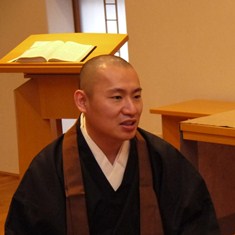Buddhist Involvement in Terminal Care and Medical Environments
May 29, 2013
Rev. Daihaku Okochi

Vice Director, Life and Rinsho Buddhists Association
The 4th seminar focused on the work of Rinsho Buddhists/chaplains in medical
environments, especially for those in terminal care. The speaker was Rev.
Daihaku Okochi, a Jodo Pure Land denomination priest and vice-abbot of Gansho-ji
temple in Osaka. As a young divinity school student, he began volunteer work
at the Nishi Nagaoka Hospital Vihara hospice ward, one of only two Buddhist
based hospices in Japan that was created in 1993 in collaboration with the
Jodo Shin Pure Land denomination’s Vihara Movement. After graduating, Rev.
Okochi spent one year as a Buddhist chaplain at the hospital before returning
to his home temple in Osaka and creating the Vihara 21 group. Just this past
year in 2012, he created the Life and Rinsho Buddhism Association.
Rev. Okochi began his talk by reflecting on the history of the Vihara Movement, first developed Rev. Masashi Tamiya, a priest of the Higashi Honganji or Otani branch of the Jodo Shin Pure Land denomination in 1985. After him, the Nishi Honganji or Honpa Hongwanji branch of the Jodo Shin denomination created Vihara Activities in 1986. Rev. Shunko Tashiro of the Higashi branch then started a Vihara movement at the Nagoya Higashi Betsuin headquarters temple as a foothold in 1988. The Nichiren denomination started their Vihara Activities in 1994. As well as these above, volunteer organizations of the Vihara Movement were formed in many cities. Some are denominationally based while others are ecumenical. There is no particular difference between the terms “Vihara Movement” and “Vihara Activities”. The term vihara was proposed as a substitute word for “hospice” and reminds us of the history of caring for the dying and destitute throughout the history of Buddhism. (see Rev. Yozo Taniyama’s chapter The Vihara Movement: Buddhist Chaplaincy and Social Welfare in Japan in Buddhist Care for the Dying and Bereaved in the Modern World: Global Perspectives Edited by Jonathan Watts and Yoshiharu Tomatsu by Wisdom Publication ? Boston & the Jodo Shu Research Institute ? Tokyo, 2012)
Rev. Okochi remarked that by the 1990s, there were calls from various sectors of society for Buddhists to become more involved in this kind of work and to show that they could do more for people than just perform funerals. Starting with Nishi Nagaoka Vihara, there are now Buddhists acting as “psycho-spiritual care volunteers” who have become intimate with patients near death in hospitals and hospices.
Rev. Okochi then introduced the most fundamental concept and practice of such psycho-spiritual work in the Japanese term yorisoi, which could be translated as “intimacy” or even “presence”. Rev. Okochi noted that if one doesn’t have space and time as a caregiver, then one can’t practice yorisoi as one’s own lifestyle agendas cannot be a priority over a patient’s process. As a Rinsho Buddhist, one ends up sharing in life together with the patient, often times not through words but though experience. In this way, Rev. Okochi emphasized that in this work one is not collecting information from patients in order to treat them. Rather, by engaging in yorisoi, one feels what the person is saying and eventually comes an understanding of the message behind their words. Sometimes one does not even have to respond as it is often not what you said but your presence. As such, there is no manual for this work and no way to have a calculating analysis for what to how to approach patients and what to say to them. This approach extends to supporting the family through their grief process. Again, it is not about curing those who grieve with some treatment but supporting them to go through their own natural process of grief
The final section of Rev. Okochi’s talk centered on the role of the Rinsho Buddhist in the Team Care work of the entire group of caring professionals, especially medical ones. He explained that the first role is to support the self-determination of the patient by supporting their communication with their own family and the medical professionals and caregivers. While acting as an advocate for the patient, the Rinsho Buddhist must also honor them not as a patient who has a limited social role in the medical environment but as a person who has had roles in society that reflect their beliefs and values. The second role is caring for the medical professionals themselves who have very rigorous and stressful work conditions. As with patients, they must be viewed holistically as people who have family roles outside of their work and thus may need support for a wide variety of issue.
The third role in Team Care involves the truly wider view of socially engaged Buddhism, which means confronting problems in the medical culture and general society that affect caregivers, patients, and family. In Japan, this means, on the micro level, dealing with the prevalent mentality of medical work as only curing illness rather than sharing in the experience of illness and offering support in a more holistic way. On the macro level, this means coming to grips with Japan’s aging society and what will become “a society of prevalent death”, which will unavoidably see a return to the traditional custom of dying at home and a greater intimacy with the dying and their path.
In this way, Rev. Okochi concluded by offering a model of the Rinsho Buddhist. It starts with their inner motivation and expresses itself in faith and religious practice. This connects with an outer practice in the intimate connection with the suffering, in this case at their bed side. On a wider level, this becomes the work and role of religious professionals in offering spiritual care in a variety of contexts.

